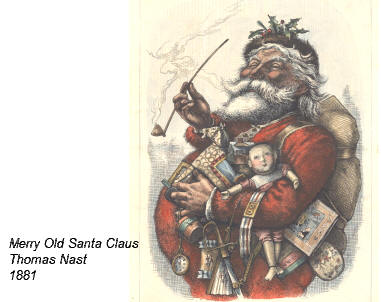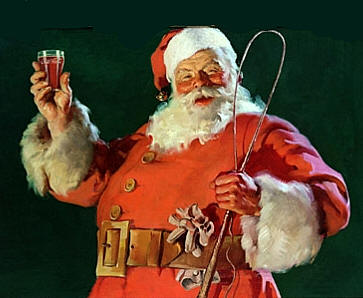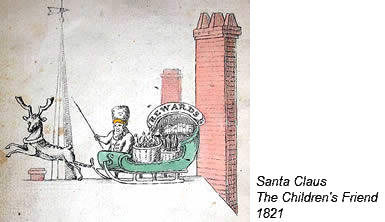Santa Claus has a hidden history that few know.-
a story that stretches all the way back to the third century. The
legend of Santa Claus can be traced back to a monk named Nicholas who
was likely born sometime around 280 A.D. in modern-day Turkey.
A Christian bishop, he was admired for his piety and kindness. Nicholas
became the subject of many legends such as that he gave away all of his
inherited wealth to help
the poor and sick. One of the best known of the St. Nicholas stories is
that he saved three poor sisters from being sold into slavery or
prostitution by their father by providing them with a dowry so that they
could be married.
Over the course of many years, Nicholas’s popularity spread and he
became known as the protector of children. He was so popular that, years
later, the Catholic church raised him to the level of saint. St.
Nichollas’ feast day is celebrated on the anniversary of his death,
December 6.
By the time of the Renaissance, St. Nicholas was the most popular saint in Europe. Even after the Protestant Reformation, when the veneration of saints began to be discouraged, St. Nicholas maintained a positive reputation, especially in Holland.
St. Nicholas made his first inroads into American popular culture
towards the end of the 18th century. In December 1773, and again in
1774, a New
York
newspaper reported that groups of Dutch families had gathered to honor
the anniversary of his death.
The name Santa Claus evolved from his Dutch nickname, Sinter Klaas, a shortened form of Sint Nikolaas (Dutch for Saint Nicholas).
In 1804, John Pintard, a member of the New York Historical Society, distributed woodcuts of St. Nicholas at the society’s annual meeting. The background of the engraving contains now-familiar Santa images including stockings filled with toys and fruit hung over a fireplace.
In
1809, Washington Irving
helped to popularize the Sinter Klaas stories when he referred to St.
Nicholas as the patron saint of New York in his book,
The History of New York.
As his prominence grew, Sinter Klaas was described as everything from a
“rascal” with a blue three-cornered hat, red waistcoat, and yellow
stockings to a man wearing a broad-brimmed hat and a “huge pair of
Flemish trunk hose.”
In 1822, Clement Clarke Moore, an Episcopal minister, wrote a long
Christmas poem for his three daughters entitled “An Account of a Visit
from St. Nicholas.” Moore’s poem, which he was initially hesitant to
publish due to the frivolous nature of its subject, is largely
responsible for our modern image of Santa Claus as a “right jolly old
elf” with a portly figure and the supernatural ability to ascend a
chimney with a mere nod of his head!
Although some of Moore’s imagery was probably borrowed from other
sources, his poem helped popularize the now-familiar image of a Santa
Claus who flew from house to house on Christmas Eve–in “a miniature
sleigh” led by eight flying reindeer–leaving presents for deserving
children. “An Account of a Visit from St. Nicholas” created a new and
immediately popular American icon.

In 1881, political cartoonist Thomas Nast drew on Moore’s poem to create
the first likeness that matches our modern image of Santa Claus. His
cartoon, which appeared in Harper’s Weekly, depicted Santa as a rotund,
cheerful man with a full, white beard, holding a sack laden with toys
for lucky children. It is Nast who gave Santa his bright red suit
trimmed with white fur, North Pole workshop, elves, and his wife, Mrs.
Claus.


What if someone were to suggest that Santa Claus was a god, a deity, a being to be worshipped?
Some would find this idea blasphemous, many would find it laughable. But, think about it. The dictionary defines. a god as:: "A being of more than human attributes or powers". Certainly 'the ability to slide down chimneys and travel around the world in minutes, to know the names and needs of every child in the world and to be able to produce billions of toys are superhuman qualities, are they not?
And aren't children taught to pray to Santa Claus, that is, don't they write him letters with their needs?
It is entirely possible that Santa Claus may be better known in association with Christmas than is the Baby Jesus. His reputation has travelled to all corners of the globe. There are few children in the U.S. who do not worship him.
We are able to trace today's Santa Claus to an origin prior to the 15th century, at which time he was known as Father Christmas, a minor figure in the mummer's plays of the mid-winter season), a being not as fat or jolly as St. Nick, but otherwise quite similar.
To trace this Christmas hero even further back in history to his origins, it will be necessary to make a list of his best-known attributes in order to recognize him under any other name. Here are the characteristics generally attributed to Santa Claus:
1). He has a white beard
2). He is dressed in red.
3). He loves children
4). He is associated with the giving of gifts.
5). He is said to be able to travel around the world almost instantly as he brings gifts to every home. 6). He is very ,old, perhaps even eternal.
Okay, those are his attribute, now here are some clues as to his origins:
(1) "His head and his hair were white with wool .” (Rev. 1:14)
(2) "And he was clothed with a vesture dipped in blood ." (Rev.19:13)
(3) "Then were brought unto him little children, that he should put his hands on them, and pray 'Suffer little children, and forbid them not'." (Matt. 19:13-14) Doesn’t this verse remind you of the children queing up to see Santa Claus?
(4) "and when they had opened their treasures, they presented unto him gifts: gold, and frankincense, and myrrh." (Matt. 2:11)
(5) "For as the lightning cometh out of the east so shall also the coming of the Son of Man be." (Matt. 24:27) And finally,
(6) Anyone who was born almost 2000 years ago certainly is old!
Yes, the character behind the mythical Santa Claus is none other than the equally mythical JESUS CHRIST!
"He's making a list and checking it twice. He's gonna find out who "s naughty or nice. Santa Claus is coming to town!" (a popular song) Doesn't that sound like the second coming of Jesus as portrayed by the fundamentalists?
Think about it!
